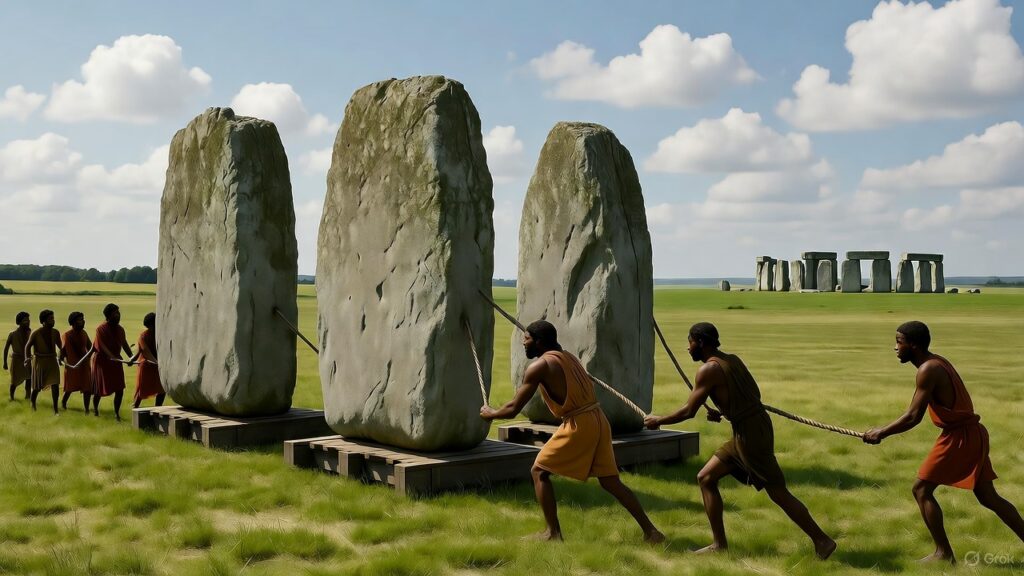A Mysterious Circle of Stones
Imagine walking into a wide, grassy field in England and suddenly spotting giant stones standing in a huge circle. Some stones are taller than a giraffe, and others weigh as much as 40 elephants! This magical place is called Stonehenge, and it has puzzled scientists, historians, and even kids like you for centuries.
Why was it built? How did people thousands of years ago move such enormous stones without modern machines? And here’s the big question: Did humans do it all by themselves—or did aliens give them a hand?
🏛️ What Exactly Is Stonehenge?
Stonehenge is one of the most famous monuments in the world. It sits in Wiltshire, England, and is believed to be around 5,000 years old. That means it was built before the pyramids of Egypt!
The structure is made up of:
- Huge standing stones arranged in a circle.
- Some stones placed on top of others, making giant “doorway” shapes.
- Smaller stones forming patterns inside the circle.
Even though many stones have fallen, the site still looks mysterious and powerful.
🧑🏫 How Did Ancient People Build It?
Here’s where the mystery deepens. Each of the biggest stones, called sarsens, weighs up to 25 tons. The smaller stones, known as bluestones, came from mountains in Wales—about 240 kilometers away!
But wait… this was around 3000–2000 BCE. There were no cranes, no trucks, no highways. So how did they move the stones?
- Some scientists think they used logs as rollers.
- Others believe they dragged stones on wooden sledges.
- Another idea says they may have floated stones on rafts along rivers.
It must have taken hundreds of people working together for many years to finish Stonehenge. But still… could humans really have done all this without help?

☀️ Stonehenge and the Sun & Stars
Here’s something super cool: Stonehenge is not just a random stone circle. The stones are lined up with the sun’s position during special times of the year.
- On the summer solstice (the longest day of the year), the sun rises exactly above the main stone.
- On the winter solstice (the shortest day), the sun sets perfectly in line with the stones.
It’s like a giant calendar made of stone! Ancient people may have used it to track seasons, know when to plant crops, or hold festivals.
But here’s the twist—was it only humans who figured this out? Or did aliens share advanced knowledge of astronomy?
👽 The Alien Landing Site Theory
Some people believe Stonehenge was more than a calendar. They think it could have been a landing pad for alien spacecraft.
Why?
- Strange Precision – The stones are placed with amazing accuracy, even without modern tools.
- Energy Lines – Some researchers believe Stonehenge sits on powerful “ley lines,” where Earth’s energy is strongest—perfect for alien navigation.
- Ancient Legends – Old stories in England mention magical giants or mysterious beings bringing the stones from faraway lands. Could those “giants” have been aliens?
- UFO Sightings Near Stonehenge – Over the years, people have reported glowing lights and UFO-like shapes in the skies above the site.
It’s no wonder Stonehenge is often linked with extraterrestrial mysteries!
🧩 Could Humans Alone Have Built It?
Not everyone believes in the alien theory. Most scientists argue that humans, though they lacked machines, were incredibly clever and resourceful.
- Ancient builders studied the stars and planned carefully.
- They had teamwork—hundreds of people could move stones using ropes and wooden tools.
- It may have taken generations, but patience and skill could have achieved it.
So maybe Stonehenge isn’t proof of aliens… maybe it’s proof of just how smart and determined humans can be!
📜 Stories and Myths About Stonehenge
For centuries, people created myths to explain Stonehenge’s mystery:
- Some said giants placed the stones there.
- Others believed Merlin the wizard from King Arthur’s legends magically built it.
- Some thought it was a portal to another world—a doorway between humans and gods (or maybe aliens!).
These stories show how magical and puzzling Stonehenge has always been to people.
🌍 Why Stonehenge Still Matters Today
Today, Stonehenge is a UNESCO World Heritage Site. Millions of tourists visit each year, especially during the summer solstice, when people gather to watch the sunrise exactly in line with the stones.
It’s more than a pile of rocks—it’s a symbol of human curiosity, mystery, and imagination. Whether it was built by humans alone or with alien help, it continues to inspire us to look up at the stars and wonder: Are we alone in the universe?
🧒 Why Kids Find Stonehenge So Cool
Stonehenge is like a giant puzzle left behind by people thousands of years ago. Kids love imagining:
- Could aliens have flown down and said, “Here, build it this way”?
- Did ancient humans have secret science we don’t know about?
- Or was it a magical meeting place for people and otherworldly visitors?
Every time we ask these questions, we practice critical thinking, imagination, and scientific curiosity—just like real explorers!
Conclusion – Mystery That Lives On
So, what do you think? Is Stonehenge an ancient astronomical calendar, carefully planned by smart humans? Or is it an alien landing site, a gift from visitors beyond the stars?
Maybe the real answer lies somewhere in between. Until we know for sure, Stonehenge will remain one of Earth’s greatest mysteries—reminding us to keep looking up, keep asking questions, and never stop imagining.